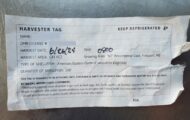Food Poisoning Bulletin publishes recalls of food for undeclared allergens from the FDA, USDA, and CFIA every week. These recalls affect just about every food on the market. Food allergies can cause reactions that range from mild to life-threatening. So what are the symptoms of common food allergies?

People can be born with food allergies, or they can appear at any time during the lifespan without warning. Some people grow out of their allergies, while others are lifelong. And children are more likely to be allergic to foods than adults.
There are some symptoms that are common to most allergens. They include tingling of the mouth, lips, and tongue; itching, rash, and hives; congestion or runny nose; nausea, vomiting, and diarrhea. These are usually early symptoms that may appear before life-threatening reactions. Symptoms can worsen with more exposure to the allergen, but reactions are unpredictable.
There are nine categories of foods that the government classifies as food allergens that must be listed on the label of every food. Those categories are: peanuts, soy, milk, wheat, eggs, fin fish, tree nuts, sesame, and shellfish. Those foods cover about 90% of the foods that people are allergic to.
Most recalls for undeclared allergens are considered Class 2 and Class 3: that is, they will cause uncomfortable symptoms but will probably not be life-threatening. There are exceptions to that rule, of course. Some people can suffer serious and deadly reactions to some of these allergens, especially if symptoms include more than one body part. And one allergen in particular, peanut, can often cause a life-threatening reaction.
There are two medical conditions that cause reactions to two food allergens: lactose intolerance (milk) and celiac disease (wheat). Many people outgrow lactose intolerance, but celiac disease can be lifelong. Symptoms of those illnesses include bloating, gas, diarrhea, fatigue, and abdominal pain. But celiac disease, if untreated, can cause malnutrition, bone weakening, infertility, anemia, and joint pain.
Anyone who is experiencing symptoms of a food allergy should see a doctor, especially the first time. These are the symptoms of common food allergies.
Peanut Allergy
Peanut allergies are the most serious of all food allergies. Some words for peanuts that may be listed on labels include arachidic acid, hydrolyzed plant protein, mandelona nuts, and arachis oil. Peanuts can be included in grain breads, honey, veggie burgers, ice cream, sauces, salad dressings, and international foods.
There may be mild symptoms that presage more serious, life-threatening conditions. Early symptoms can include itching or tingling in the mouth and throat, tightening of the throat, shortness of breath, wheezing, runny nose, diarrhea, stomach cramps, nausea, vomiting, and hives, redness, or swelling.
Life-threatening symptoms of a peanut allergy include constriction of the airways, swelling of the throat, a severe drop in blood pressure (shock), rapid pulse, dizziness, lightheadedness, and loss of consciousness. These symptoms constitute a medical emergency.
Milk Allergy
Milk can be present in many different foods, including processed meats, fruit drinks, cereal, peanut butter, fruit juices, sausages, soups, hard candy, and ketchup. The word “nondairy” does not mean it is milk-free; that food on a label means the food may have other milk-containing ingredients. Words that mean “milk” include casein, ghee, lactalbumin, and lactoglobulin.
Symptoms of a milk allergy include stomach cramps, diarrhea, vomiting, nausea, rash, hives, red itchy skin, runny nose, coughing, wheezing, and swelling of the eyes fact, lips, throat, and tongue.
Soy Allergy
Soy can be present in many foods, such as breads, cereals, canned broths and soups, processed meats, and Worcestershire sauce. Words to look for on labels that can mean soy include tamari, tempeh, textured vegetable protein, natty, and miso.
Symptoms of a soy allergy include tingling of the mouth, lips, and tongue, hives or itching, swelling of the mouth, lips, or other body parts, wheezing, stomach pain, nausea, vomiting, and red skin.
Wheat Allergy
Wheat can be present in many foods that aren’t bread, cakes, or crackers. You sometimes can find it in beer, candy, hot dogs, imitation crab meat, marinara sauce, ice cream, pasta, potato chips, salad dressings, sauces, and processed meats. Words to look for include emmer, farina, carrot, freaked, couscous, bulgur, triticale, and vital wheat gluten.
Symptoms of an allergy to wheat include swelling, itching, or irritation of the mouth or throat, hives, itchy rash, skin swelling, headache, nasal congestion, difficulty breathing, cramps, nausea, vomiting, diarrhea, and anaphylaxis.
Egg Allergy
Eggs can hide in many processed foods, including surimi, mayonnaise, baked goods, pasta, marzipan, marshmallows, coffee drinks, protein shakes, and ice cream. Terms to look for on labels include albumin, globulin, livetin, ovomucin, and silica albuminate.
Egg allergy symptoms include skin inflammation and hives, nasal congestion, sneezing, cramps, nausea, vomiting, coughing, wheezing, chest tightness, and shortness of breath.
Fin Fish Allergy
Fin fish include tuna, salmon, swordfish, red snapper, grouper, cod, and walleye, among others. Fish are sometimes used as an ingredient in Worcestershire sauce, surimi, gelatin, Caesar salad, and barbecue sauces. Symptoms of a fin fish allergy include hives, swelling of the lips, tingling of the mouth and throat, itchy skin and rash, runny nose, tightening of the throat, cramps, stomach pain, nausea, and vomiting.
Shellfish Allergy
Shellfish, or crustaceans, include crab, crawfish, langoustines lobster, prawns, sea urchin, and shrimp. Some people are allergic to mollusks, which include clams, mussels, oysters, and scallops, but those foods are not covered in the Big 8. Foods that are sometimes made with shellfish include Vietnamese fish sauce, and foods such as Gumbo, Cioppino, and Bouillabaisse.
Symptoms of a shellfish allergy include hives, itching, swelling of the lips, face, tongue, throat, or other body parts, wheezing, nasal congestion, difficulty breathing, abdominal pain, diarrhea, nausea, vomiting, dizziness, lightheadedness, and fainting.
Tree Nut Allergy
Tree nuts include cashews, walnuts, pecans, macadamia nuts, Brazil nuts, almonds, filberts, hickory nuts, pine nuts, and pistachios. Some people are allergic to coconut. Foods that can contain nuts include candy, soups, ice cream, puddings, hot chocolate, honey, veggie burgers, sauces, and salad dressings.
Symptoms of a nut allergy include hives, swelling of the lips, tingling of the throat and mouth, itchy skin and rash, runny nose, tightening of the throat, cramps, stomach pain, nausea, or vomiting.
Sesame Allergy
This allergen was added to the major food allergen groups after the FASTER Act passed in April 2021. More than 1,600,000 Americans are allergic to sesame seeds and products made with them, including sesame oil. And the number of people allergic to this food has been increasing in recent years.
Symptoms of a sesame allergy include itchiness in the mouth, face flunking, coughing, nausea, vomiting, a low pulse rate, difficulty breathing, and abdominal pain.
Protect Yourself
Now that you know the symptoms of common food allergies you can protect yourself. If you have a food allergy it is important that you stay up to date on all food recalls. In addition, you should carefully read the ingredient list of all packaged foods you buy. Corporations can change the composition of their products any time without notice. All of the major food allergens are required to be listed on the package by law, but mistakes happen.
And some people are allergic to foods and ingredients that are not part of the Big 8, such as sesame seeds and food dyes like Yellow #5. Those ingredients should be listed on the label, but if a food dye, for instance, is an ingredient in a sub-ingredient, it may not be listed because it is not in the Big 8. In those cases, watch for symptoms and take action if necessary.
If you are allergic to one or more foods, always carry an Epipen with you. And tell those around you that you are allergic so they can help if necessary.




